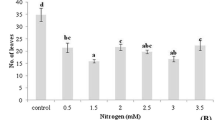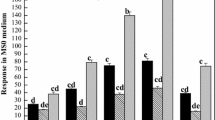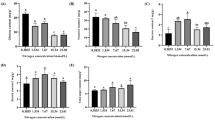Abstract
This study elucidated the effect of exogenous sucrose on growth parameters and metabolic changes during the in vitro rooting (InVR) and the ex vitro acclimatization (ExVA) stages of potato (Solanum tuberosum L.). During InVR stage, plantlets were cultured on MS medium with 3 % (S+) or without (S−) sucrose, and were then acclimatized under the same ExVA condition. In InVR stage, S+ increased photosynthetic capacity (Amax) and dry matter percentage. Yet, no significant differences in the other growth parameters have been observed. During acclimatization, Amax and respiration were higher in ExVA compared to InVR plants. Most growth parameters were significantly higher in S+ plants. Principal component analysis and hierarchical cluster analysis of 108 metabolites identified by GC–MS clearly demonstrated that in vitro culture had a profound impact on metabolic profile. In vitro S− and S+ plantlets accumulated large quantities of amino acids (specially under S+), photorespiration intermediates, putrescine, tocopherol and organic acids, including oxalic and tartaric acid. However, glycolytic and TCA cycle intermediates were found in lower amount. Under InVR S+ conditions, proline, gamma-aminobutyric acid, sugars and sugar alcohols accumulated in larger amounts. InVR S− plantlets characteristically accumulated large quantity of urea. We suggest that ammonia metabolism was redirected towards urea biosynthesis through urea cycle to sequester nitrogen in condition of low carbon availability. In vitro conditions are causing major disruption in the cellular metabolism, which could produce serious consequences on the capacity of plantlets to adapt to uncontrolled growing conditions and may lead to poor development under these conditions.







Similar content being viewed by others
Abbreviations
- MS:
-
Murashige and Skoog (1962) medium
- Amax :
-
Light saturated photosynthesis
- S−:
-
Culture medium without sugar
- S+:
-
Culture medium with sugar
- GC–MS:
-
Gas chromatography–mass spectrometry
- TAC:
-
Tricarboxylic acid cycle
- UC:
-
Urea cycle
- GABA:
-
Gamma-aminobutyric acid
- PCA:
-
Principal component analysis
- 3PGA:
-
3 Phosphoglyceric acid
- PAs:
-
Polyamines
- Put:
-
Putrescine
- Spd:
-
Spermidine
References
Alcázar R, Altabella T, Marco F, Bortolotti C, Reymond M, Koncz C, Carrasco P, Tiburcio AF (2010) Polyamines: molecules with regulatory functions in plant abiotic stress tolerance. Planta Med 231(6):1237–1249
Ashraf M, Foolad M (2007) Roles of glycine betaine and proline in improving plant abiotic stress resistance. Environ Exp Bot 59(2):206–216
Badr A, Angers P, Desjardins Y (2011) Metabolic profiling of photoautotrophic and photomixotrophic potato plantlets (Solanum tuberosum) provides new insights into acclimatization. Plant Cell Tissue Org Cult 107(1):13–24
Beharrell B, MacFie J (1991) Consumer attitudes to organic foods. Br Food J 93(2):25–30
Boardman NK (1977) Comparative photosynthesis of sun and shade plants. Annu Rev Plant Physiol 28(1):355–377
Bohnert HJ, Jensen RG (1996) Strategies for engineering water-stress tolerance in plants. Trends Biotechnol 14(3):89–97
Bouché N, Fromm H (2004) GABA in plants: just a metabolite? Trends Plant Sci 9(3):110–115
Bouchereau A, Aziz A, Larher F, Martin-Tanguy J (1999) Polyamines and environmental challenges: recent development. Plant Sci 140:103–125
Carvalho LC, Osório ML, Chaves MM, Amâncio S (2001) Chlorophyll fluorescence as an indicator of photosynthetic functioning of in vitro grapevine and chestnut plantlets under ex vitro acclimatization. Plant Cell Tissue Org Cult 67(3):271–280
Castro A, Young M, Alvarenga A, Alves J (2001) Influence of photoperiod on the accumulation of allantoin in comfrey plants. Rev Bras Fisiol Veg 13:49–54
Cha-um S, Kirdmanee C (2008) Effects of osmotic stress on proline accumulation, photosynthetic abilities and growth of sugarcane plantlets (Saccharum officinarum L.). Pak J Bot 40(6):2541–2552
Choi M-Y, Choi W, Park JH, Lim J, Kwon SW (2010) Determination of coffee origins by integrated metabolomic approach of combining multiple analytical data. Food Chem 121(4):1260–1268
Collakova E, DellaPenna D (2001) Isolation and functional analysis of homogentisate phytyltransferase from synechocystis sp. PCC 6803 and arabidopsis. Plant Physiol 127(3):1113–1124
Cournac L, Dimon B, Carrier P, Lohou A, Chagvardieff P (1991) Growth and photosynthetic characteristics of Solanum tuberosum plantlets cultivated in vitro in different conditions of aeration, sucrose supply, and CO2 enrichment. Plant Physiol 97(1):112–117. doi:10.1104/pp.97.1.112
Desjardins Y, Dubuc J, Badr A (2007) In vitro culture of plants: a stressful activity! Acta Hortic 812:29–50
Doumett S, Lamperi L, Checchini L, Azzarello E, Mugnai S, Mancuso S, Petruzzelli G, Del Bubba M (2008) Heavy metal distribution between contaminated soil and Paulownia tomentosa, in a pilot-scale assisted phytoremediation study: influence of different complexing agents. Chemosphere 72(10):1481–1490
Ehness R, Ecker M, Godt DE, Roitsch T (1997) Glucose and stress independently regulate source and sink metabolism and defense mechanism via signal transduction pathways involving protein phosphorylation. Plant Cell 9:1825–1845
Eskling M, Åkerlund H-E (1998) Changes in the quantities of violaxanthin de-epoxidase, xanthophylls and ascorbate in spinach upon shift from low to high light. Photosynth Res 57(1):41–50
Fait A, Fromm H, Walter D, Galili G, Fernie AR (2008) Highway or byway: the metabolic role of the GABA shunt in plants. Trends Plant Sci 13(1):14–19
Foyer CH, Noctor G (2003) Redox sensing and signalling associated with reactive oxygen in chloroplasts, peroxisomes and mitochondria. Physiol Plant 119(3):355–364
Foyer C, Rowell J, Walker D (1983) Measurement of the ascorbate content of spinach leaf protoplasts and chloroplasts during illumination. Planta 157(3):239–244
Franceschi VR, Nakata PA (2005) Calcium oxalate in plants: formation and function. Annu Rev Plant Biol 56(1):41–71
Gaspar T, Franck T, Bisbis B, Kevers C, Jouve L, Hausman JF, Dommes J (2002) Concepts in plant stress physiology. Application to plant tissue cultures. Plant Growth Regul 37(3):263–285
George E, Hall M, De Klerk G (2007) Plant propagation by tissue culture: 1. The background. Springer, Dordrecht
Gill SS, Tuteja N (2010) Polyamines and abiotic stress tolerance in plants. Plant Signal Behav 5(1):26–33
Grigore M-N, Boscaiu Neagu MT, Vicente Meana Ó (2011) Assessment of the relevance of osmolyte biosynthesis for salt tolerance of halophytes under natural conditions. Eur J Plant Sci Biotech 5:12–19
Grout BWW (1988) Photosynthesis of regenerated plantlets in vitro, and the stress of transplanting. Acta Hortic 230:129–135
Hare PD, Cress WA, Van Staden J (1998) Dissecting the roles of osmolyte accumulation during stress. Plant, Cell Environ 21(6):535–553
Shao H-b, Chu L-y, Shao M-a, Jaleel CA, Hong-mei M (2008) Higher plant antioxidants and redox signaling under environmental stresses. C R Biol 331(6):433–441
Hdider C, Desjardins Y (1994) Effects of sucrose on photosynthesis and phosphoenolpyruvate carboxylase activity of in vitro cultured strawberry plantlets. Plant Cell Tissue Org Cult 36(1):27–33
Hocking P (2001) Organic acids exuded from roots in phosphorus uptake and aluminum tolerance of plants in acid soils. Adv Agron 74:64–99
Jeong ML, Jiang H, Chen H-S, Tsai C-J, Harding SA (2004) Metabolic profiling of the sink-to-source transition in developing leaves of quaking aspen. Plant Physiol 136(2):3364–3375
Jo E-A, Tewari R, Hahn E-J, Paek K-Y (2009) In vitro sucrose concentration affects growth and acclimatization of Alocasia amazonica plantlets. Plant Cell Tissue Org Cult 96(3):307–315
Joyce SM, Cassells AC, Jain SM (2003) Stress and aberrant phenotypes in vitro culture. Plant Cell Tissue Org Cult 74(2):103–121
Kinnersley AM, Turano FJ (2000) Gamma aminobutyric acid (GABA) and plant responses to stress. Crit Rev Plant Sci 19(6):479–509
Kovtun Y, Daie J (1995) End-product control of carbon metabolism in culture-grown sugar beet plants (molecular and physiological evidence on accelerated leaf development and enhanced gene expression). Plant Physiol 108(4):1647–1656
Kozai T, Watanabe K, Jeong B (1995) Stem elongation and growth of Solanum tuberosum L. in vitro in response to photosynthetic photon flux, photoperiod and difference in photoperiod and dark period temperatures. Sci Hortic 64(1–2):1–9
Levy D (1983) Water deficit enhancement of proline and α-amino nitrogen accumulation in potato plants and its association with susceptibility to drought. Physiol Plant 57(1):169–173
Liu J-H, Kitashiba H, Wang J, Ban Y, Moriguchi T (2007) Polyamines and their ability to provide environmental stress tolerance to plants. Plant Biotechnol 24(1):117–126
Mansour MMF (1998) Protection of plasma membrane of onion epidermal cells by glycinebetaine and proline against NaCl stress. Plant Physiol Biochem 36(10):767–772
Martin-Tanguy J (2001) Metabolism and function of polyamines in plants: recent development (new approaches). Plant Growth Regul 34(1):135–148
Morcuende R, Krapp A, Hurry V, Stitt M (1998) Sucrose-feeding leads to increased rates of nitrate assimilation, increased rates of -oxoglutarate synthesis, and increased synthesis of a wide spectrum of amino acids in tobacco leaves. Planta 206(3):394–409
Muller-Moule P, Golan T, Niyogi KK (2004) Ascorbate-deficient mutants of arabidopsis grow in high light despite chronic photooxidative stress. Plant Physiol 134(3):1163–1172
Munné-Bosch S, Alegre L (2002) Interplay between ascorbic acid and lipophilic antioxidant defences in chloroplasts of water-stressed arabidopsis plants. FEBS Lett 524(1–3):145–148
Murashige T, Skoog F (1962) A revised medium for rapid growth and bio assays with tobacco tissue cultures. Physiol Plant 15(3):473–497
Noctor G (2006) Metabolic signalling in defence and stress: the central roles of soluble redox couples. Plant, Cell Environ 29(3):409–425
Noiraud N, Maurousset L, Lemoine R (2001) Transport of polyols in higher plants. Plant Physiol Biochem 39(9):717–728
Obata T, Fernie AR (2012) The use of metabolomics to dissect plant responses to abiotic stresses. Cell Mol Life Sci 69(19):3225–3243
Pospisilova J, Ticha I, Kadlecek P, Haisel D, Plzakova S (1999) Acclimatization of micropropagated plantlets to ex vitro conditions. Biol Plant 42(4):481–487
Premakumar A, Mercado JA, Quesada MA (2001) Effects of in vitro tissue culture conditions and acclimatization on the content of Rubisco, leaf soluble proteins, photosynthetic pigments, and C/N ratio. J Plant Physiol 158(7):835–840
Reinbothe H, Mothes K (1962) Urea, ureides, and guanidines in plants. Annu Rev Plant Physiol 13(1):129–149
Rodziewicz P, Swarcewicz B, Chmielewska K, Wojakowska A, Stobiecki M (2014) Influence of abiotic stresses on plant proteome and metabolome changes. Acta Physiol Plant 36(1):1–19
Roessner U, Wagner C, Kopka J, Trethewey R, Willmitzer L (2000) Simultaneous analysis of metabolites in potato tuber by gas chromatography–mass spectrometry. Plant J 23(1):131–142
Roessner-Tunali U, Hegemann B, Lytovchenko A, Carrari F, Bruedigam C, Granot D, Fernie AR (2003) Metabolic profiling of transgenic tomato plants overexpressing hexokinase reveals that the influence of hexose phosphorylation diminishes during fruit development. Plant Physiol Biochem 133(1):84–99
Rolland F, Baena-Gonzalez E, Sheen J (2006) Sugar sensing and signaling in plants: conserved and novel mechanisms. Annu Rev Plant Biol 57:675–709
Sakai T, Sakamoto T, Hallaert J, Vandamme EJ (1993) Pectin, pectinase, and protopectinase: production, properties, and applications. In: Saul N, Allen IL (eds) Advances in applied microbiology, vol 39. Academic Press, London, pp 213–294
Shao H, Chu L (2005) Plant molecular biology in China: opportunities and challenges. Plant Molecular Biology Reporter 23(4):345–358
Shelp BJ, Bown AW, McLean MD (1999) Metabolism and functions of gamma-aminobutyric acid. Trends Plant Sci 4(11):446–452
Sima B, Desjardins Y (2001) Sucrose supply enhances phosphoenolpyruvate carboxylase phosphorylation level in in vitro Solanum tuberosum. Plant Cell Tissue Org Cult 67(3):235–242
Sima B, Desjardins Y, Van Quy L (2001) Sucrose enhances phosphoenolpyruvate carboxylase activity of in vitro Solanum tuberosum L. under non-limiting nitrogen conditions. In Vitro Cell Dev Biol Plant 37(4):480–489
Smith AM, Stitt M (2007) Coordination of carbon supply and plant growth. Plant, Cell Environ 30(9):1126–1149
Stepansky A, Leustek T (2006) Histidine biosynthesis in plants. Amino Acids 30(2):127–142
Stitt M, Müller C, Matt P, Gibon Y, Carillo P, Morcuende R, Scheible WR, Krapp A (2002) Steps towards an integrated view of nitrogen metabolism. J Exp Bot 53(370):959–970
Taiz L, Zeiger E (2010) Plant physiology, 5th edn. Sinauer Associates Inc, Sunderland
Tekam ML, Desire TV, Marius-Nicusor G, Maria ZM, Emmanuel Y, Akoa A (2014) Differential responses of growth, chlorophyll content, lipid peroxidation and accumulation of compatible solutes to salt stress in peanut (Arachis hypogaea L.) cultivars. Afr J Biotechnol 13(50):4577–4585
Todd CD, Tipton PA, Blevins DG, Piedras P, Pineda M, Polacco JC (2006) Update on ureide degradation in legumes. J Exp Bot 57(1):5–12
Valero-Aracama C, Wilson S, Kane M, Philman N (2007) Influence of in vitro growth conditions on in vitro and ex vitro photosynthetic rates of easy-and difficult-to-acclimatize sea oats (Uniola paniculata L.) genotypes. In Vitro Cell Dev Biol Plant 43(3):237–246
Van Huylenbroeck JM, Debergh PC (1996) Impact of sugar concentration in vitro on photosynthesis and carbon metabolism during ex vitro acclimatization of Spathiphyllum plantlets. Physiol Plant 96(2):298–304
Venkatesan A, Chellappan KP (1998) Accumulation of proline and glycine betaine in Ipomoea pes-caprae induced by NaCl. Biol Plant 41(2):271–276
Wang P, Kong C, Hu F, Xu X (2007) Allantoin involved in species interactions with rice and other organisms in paddy soil. Plant Soil 296(1):43–51
Witte C-P, Medina-Escobar N (2001) In-gel detection of urease with nitroblue tetrazolium and quantification of the enzyme from different crop plants using the indophenol reaction. Anal Biochem 290(1):102–107
Acknowledgments
Thanks to the Egyptian Higher Education and its Missions General Administration for their financial assistance. The authors also wish to thanks NSERC discovery Grant program for their financial support to Yves Desjardins.
Author information
Authors and Affiliations
Corresponding author
Electronic supplementary material
Below is the link to the electronic supplementary material.
Fig.S1
Changes in metabolites extracted from the leaves of potato (Solanum tuberosum L., cv Norland) grown on 3% and 0% sucrose during in vitro rooting and ex vitro acclimatization stages. The results are mean ± SD (n=15), error bars are not shown where they are smaller than the symbol. a, metabolites 1-36; b, metabolites 37-72 ; c, metabolites 73-107 (TIFF 55130 kb)
Fig.S2
Changes in all identified metabolites recovered in methanolic extracts from leaves of potato (Solanum tuberosum L., cv Norland) grown on 3% sucrose, S+ (A, B and C) and 0% sucrose, S- (D, E and F) during in vitro rooting stage (A and D) and ex vitro acclimatization stage (B, C, E and F). Metabolites are shown in order of decreasing normalized peak area in in vitro S+ leaf (A) (TIFF 26721 kb)
Fig.S3
PCA loading plot representing the contribution of individual metabolites to principal component clustering of potato leaves plantlet (Solanum tuberosum L., cv Norland) grown on 0% or 3% sucrose in in vitro rooting stage (TIFF 1259 kb)
Rights and permissions
About this article
Cite this article
Badr, A., Angers, P. & Desjardins, Y. Comprehensive analysis of in vitro to ex vitro transition of tissue cultured potato plantlets grown with or without sucrose using metabolic profiling technique. Plant Cell Tiss Organ Cult 122, 491–508 (2015). https://doi.org/10.1007/s11240-015-0786-3
Received:
Accepted:
Published:
Issue Date:
DOI: https://doi.org/10.1007/s11240-015-0786-3




